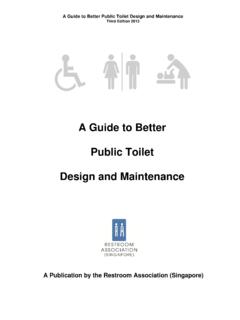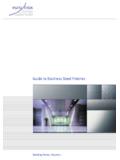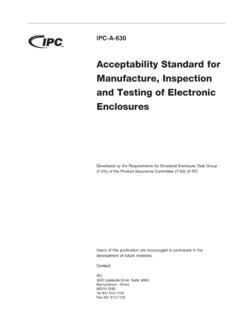Transcription of A Guide to Better - Restroom Association
1 A Guide to Better Public Toilet Design and Maintenance Third Edition 2013 A Guide to Better Public Toilet Design and Maintenance A Publication by the Restroom Association (Singapore) A Guide to Better Public Toilet Design and Maintenance Third Edition 2013 1 CONTENTS PAGE DEFINITION OF A WELL DESIGNED TOILET 2 I) DESIGN Introduction 3 Layout 3 Lighting 5 Materials 6 Urinals 8 Water Closets (WCs) 9 Wash Basins 11 Provision of Facilities 12 Special Needs and User-Friendly Features 15 Installation Standards 16 Ventilation System 17 Plumbing and Sewerage System 19 Looscaping 20 Security and Vandalism Measures 21 II)
2 MAINTENANCE Sequence of Cleaning 23 Scheduled Cleaning 24 Timing and Frequency of Cleaning 24 Basic Equipment and Supplies 25 Correct Use of Cleaning Agents 25 Green Cleaning Agents 25 Mechanical Ventilation System 27 Training 27 Selecting a Cleaning Contractor 28 Performance-Based Contracts 28 Coating Technology for Ease of Cleaning 29 NEA s Enhanced Clean Mark Accreditation Scheme 29 III) USER EDUCATION Influencing Good User Behaviour 30 Toilet Educational Materials 31 Public Outreach 33 ILLUSTRATIONS 35 50 APPENDICES 51 64 SUGGESTED LAYOUT OF PUBLIC TOILETS 65 68 DO S AND DON TS IN DESIGNING TOILETS 69 77 ACKNOWLEDGEMENTS
3 78 A Guide to Better Public Toilet Design and Maintenance Third Edition 2013 2 Definition of A Well Designed Toilet Anyone, who has ever been in an overcrowded or uncomfortable public toilet, will value a good toilet design. The usual demands placed on a high-profile, high traffic and heavily used facility requires extra thoughts for each process. A well-designed public toilet has to be: (a) Clean and dry (b) Well ventilated (c) Easy to maintain (d) Carefully planned layout (e) Friendly to persons with disabilities and special needs There are various types of toilets: 1.
4 Public toilets provided by shopping centres, supermarkets, wet markets, eating establishments, food centres, bars, nightclubs, conference halls, cinemas, theatres, parks, tourist sites, public resorts, piers, bus terminals, MRT stations, stadiums, public swimming pools and petrol stations. Use of these facilities is generally open to any member of the public or restricted to the patrons of the owner of the facility. 2. Private toilets for staff in offices, factories or occupants of buildings where the use is restricted to patrons of the service provider or by the building management. 3. Private Residences (This is beyond the scope of this guidebook) Public toilets are places where one is obliged to ease oneself in unfamiliar surroundings among the strangers of the same sex.
5 Therefore, the fundamental principles of design of toilets include psychological studies and not just physical clearances and space requirement. While the NEA s Code of Practice on Environmental Health (COPEH) stipulates the minimum basic design criteria to address public health concerns, this Guide covers some of the best practices and good examples of toilet design that look beyond public health concerns such as user convenience and satisfaction. A Guide to Better Public Toilet Design and Maintenance Third Edition 2013 3I Design Introduction A number of different activity spaces are shown in the diagram (See Illustration 1): space occupied by the appliances itself, additional space required by the user and further space for their own belongings or circulation within the toilets.
6 In many cases, these latter spaces may overlap on occasion. Common sense will dictate when this is appropriate and when it is not. Placing the appliances in order of use simplifies the circulation and reduces the distance travelled by the user. Using sensor-operated appliances should encourage hygiene. It is difficult and costly to insulate the toilets acoustically and this problem can be resolved by planning isolation as much as possible. No unsupervised installation can prevent vandalism. Even with the most vandal-resistant appliances, an unsupervised facility will eventually become sub-standard. In most cases, facility engineers and cleaning attendants play an important role, which will result in well-maintained toilets.
7 However, all designs should allow for individual items to be replaced. Pipe work, traps and electrical supplies should be concealed for aesthetic and hygiene reasons. Layout Single entrance/exit plans work satisfactorily provided the path of the users do not cross each other and the main entrance is wide enough. Dispensing with the main entrance door to the public toilet not only helps to improve the ventilation within the toilet but also minimizes hand contact for hygiene reasons (See Illustration 2). The main entrance shall preferably have no door, and the cubicles, urinals and mirrors shall be away from the line of sight from the main entrance.
8 For example, the A Guide to Better Public Toilet Design and Maintenance Third Edition 2013 4door can be replaced by offset entrance maze which blocks the view yet allows easier, hands-free access. For installation of main entrance without doors, there are several screening arrangements showing the visibility from outside in each case (See Illustration 3). Consideration should be given to the positioning of the mirrors and to the gaps created by the hinges. For example, the access entrance to male public toilets should not open directly to the urinal area. Avoid entrances opening onto a wall surface with the mirror reflecting the urinals.
9 (See Illustration 4) Public toilets should be designed to minimise hand contact as far as possible for hygienic reasons. electronic products for toilets such as flush valves and faucets require minimum maintenance but offer enhanced operations that promote sanitation and perceived cleanliness because of hands-free operation. Location of accessible toilets should not be too remote from the main traffic area to avoid long travel distance. It should be easily accessible for those with urgency for the users. Directional signs leading to such toilets should meet the requirements specified in Building and Construction Authority's (BCA) Code on Accessibility in the Built Environment (See Illustration 5).
10 Visit BCA's website at for the latest Code. Clear signage should be designated for each gender of required public toilet facilities. The location of the signs should be near the entrance to each toilet facility and clearly displayed at noticeable locations in main traffic passageways to direct the public to the toilets. The design of signage should be of a commonly recognized female and/or male figure in dark colour contrasted on a light background. Clear signage should be displayed within the toilet indicating the name of cleaning attendant and/or cleaning company and scheduled toilet cleaning time(s).









